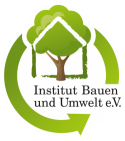From EPDs to LEED Certificates to CO2-Neutral Urban Districts
Kay Killmann, President of the German Green Building Association (GGBA), has a mission: ensuring that environmental product declarations are available for every product installed in a building. During a presentation at the EUREF campus in Berlin, he emphasised that this is because ‘they contribute to the construction of sustainable buildings and are also very much in demand’. His presentation was held for members of the Institut Bauen und Umwelt e.V. (IBU), who are committed to sustainable building and who were meeting at the EUREF campus for this year’s Members’ Day. The focus was on providing first-hand experience with the LEED building certification system as exemplified by the certified buildings on the 55,000 square metre site as well as allowing for a lively professional exchange.
IBU Members Impressed by Reference Location for Sustainable Energy Solutions

The zeeMobase on the EUREF campus is a showroom for micro smart grid solutions.
‘We instituted our annual Members’ Day so that we could meet and, together, first-hand, examine buildings that have been successfully commissioned and certified sustainable, giving us the opportunity to take a look at their effectiveness,’ explained the IBU press spokesperson. Since 2008, the EUREF campus has been the site of the transformation of an industrial monument into both a CO2-neutral urban district and a reference site for sustainable energy solutions. This office and science campus serves as a model of feasible and affordable energy transition. Here, the German government’s 2050 climate targets had already been achieved by January 2014. The IBU’s members were impressed by the multiple-award-winning overall concept, in which research and training facilities, along with more than 100 sustainability-oriented companies, have rented energy-efficient rooms in modern buildings. All of the new buildings constructed to date have been awarded either gold or platinum LEED certificates. They were designed as energy-efficient green buildings and are integrated into an intelligent energy grid. For the tenants, this means reduced energy consumption and lower operating costs.
IBU Provides Digital, Need-Based Product Sustainability Information

How does Leed certification work? Kay Killmann, President of the German Green Building Association (GGBA) describes the path to sustainability certification for buildings.
Representatives from the sustainability, construction, and building certification industries all agree on the importance of well-founded product information for sustainable construction. Environmental product declarations (EPDs) based on life-cycle-assessments, i.e., which are scientifically sound, transparent, and standard-compliant, provide basic information for assessing the ecological quality of a building. ‘With their EPDs, the IBU’s member companies and associations are making an important contribution to sustainable construction,’ stated Killmann, who went on to praise the organisation’s excellent cooperation with the building materials industry as well as the quality of IBU EPDs. In order to increasingly simplify tasks for such users as architects, planners, and auditors, as well as to further promote sustainable construction, the IBU makes EPDs available in digital format on its IBU.data platform, facilitating their use for further processing – e.g. in Building Information Modeling methodology (BIM). In addition, the IBU is also developing a special product information system to allow manufacturers to specifically meet the information requirements of the different building certification systems. Whether or not an EPD already exists, all certification-relevant information about a specific product can be compiled in a matrix and transmitted as a fact sheet that supplies the information needed to meet the individual requirements. IBU members who have already created an EPD for their product will be verified by the IBU. Non-members, however, are also meant to be able to use the IBU information system.
‘LEED Building Site’ Requires Communication and Integral Planning

Michael Schladebach, Project Manager at Wolff & Müller, participated in the Leed certification of the EUREF campus.
General contractor Wolff & Müller cemented its commitment to sustainability by making it a component of its corporate policy; the company was contracted to construct nearly all of the buildings on the EUREF campus. Wolff & Müller identified a number of actions that needed to be taken to enable the development of concrete sustainability indicators for measuring and illuminating the company’s success with its own undertakings. Managing Director Hubert Nopper and Project Manager Michael Schladebach provided information about the activities of this CO2-neutral company, which moved into offices on the EUREF campus in September 2016. ‘We are well-versed with the special features of a LEED construction site – we work closely together with our clients and consult not only them, but everyone involved in the project,’ says Schladebach. ‘Sustainable construction means taking sustainability requirements into account at an early stage of the planning’. Up-to-date data sheets with sustainability-relevant information on individual construction products are extremely helpful. For the audience members from the building materials industry, this was both a validation and an appeal. Accessibility to the right contact persons is equally important, especially in cases, ‘where we have questions about materials or environmental requirements’. Ultimately, a multitude of factors must be taken into consideration in the development of the building site, from appropriate waste disposal to documentation to collaboration with subcontractors.
The next presenter was one such subcontractor, Axel Hördt, Head of Application Center Building at Schneider Electric, which is also a building tenant. He presented information on intelligent energy management on the EUREF campus – from energy generation and storage to consumption. ‘Energy will only be consumed when someone enters a room. Light sensors indicate which rooms are occupied’. Using this as an example, he illustrated how the energy generated, which is predominantly CO2-neutral, is put to efficient use. Intelligent decentralised power grids, known as ‘micro smart grids’, ensure optimum management of grid and energy loads. He demonstrated how state-of-the-art information and automation technologies enable continuous monitoring and flexible adjustments that compensate for the constant fluctuation between energy supply and demand.

Axel Hördt, Head of Application Center Building at Schneider Electric presents information on intelligent energy management on the EUREF campus.
